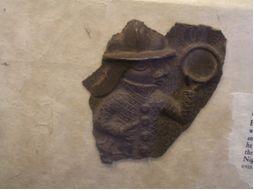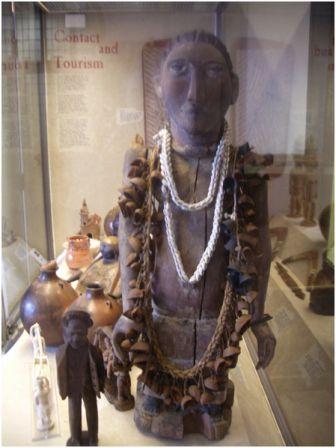In Greater Manchester
- How money from slavery made Greater Manchester
- The importance of cotton in north west England
- The Lancashire cotton famine
- Smoking, drinking and the British sweet tooth
- Black presence in Britain and north west England
- Resistance and campaigns for abolition
- The bicentenary of British abolition
Global
Africa, the arrival of Europeans and the transatlantic slave trade
Trade between Europe and Africa
by Dr Emma Poulter
Before the horrific trade in human ‘goods' began between Europe and west Africa, Europeans, particularly the Dutch and the Portuguese, had already begun trading items such as cloth and metal ware with west African countries as early as the fifteenth century. In return they received spices such as pepper as well as raw materials including ivory and gold.

This fragment of a plaque from Benin on display at the Manchester Museum depicts a Portuguese soldier and is dated to the sixteenth century.
It was the transatlantic slave trade however which gave the impetus for the enormous growth in trade between west Africa and Britain from the eighteenth century onwards, and established trade routes between the two countries which continue in use to this day. During the eighteenth century more than 11,000 British ships traded in enslaved Africans, more than half originating from Liverpool.
A number of the objects in the west African collections at the Manchester Museum were collected in towns such as Bonny, Calabar, Brass and Warri which are situated beside creeks and inlets along the low-lying coastal plain of the Niger Delta. These had grown up around settlements originally established as slave trade markets but were later used to facilitate the trade of goods such as palm oil, which became vital to the industrial needs of Manchester.

According to William Fagg, the striking style of the figure above was probably inspired by the figureheads on European ships, including slave vessels, which were a common sight in Brass for centuries. It was possibly made in order to control or harness the powerful force of these incomers. In a letter written to the then Keeper of Ethnography George Bankes in 2000, a relation of Mr Sowood wrote:
'My aunt, Mr Sowood's youngest daughter, told me that some of his 'boys' brought it to him at the quay-side when he was leaving for England. It was all boxed up and he did not know what was in it until he got home. He recognised it as having come from a ju-ju house and would not have accepted it if he had known, as it was an object of worship.'
The transatlantic slave trade, however, was not only reliant on Europeans. The trading systems required to enable slavery also depended on African middlemen who formed an intricate network throughout western Africa, supplying captured Africans from inland and arranging the caravans via which they were marched, shackled, to the coast where they were traded. Kingdoms such as Kumasi (former Ashanti capital) in present day Ghana and Dahomey and Benin in Nigeria grew large and prosperous from the money they made from trading enslaved Africans to Europeans.
The only contact with Africa that European slave traders had during this period, was therefore conducted along the west African beaches. The basis of the relationship between Europeans and coastal Africans was purely one of commercial interest. In order to legitimate the large-scale sale of humans as commodities over a period of 300 years, any understanding of the cultures from which these enslaved Africans belonged were nullified in order to promote the idea of African peoples as ‘primitives'.
As the historian James Walvin points out:
'European trading had a transforming impact on Africa. Europeans poured into Africa enormous volumes of commerce, the whole range of European manufactured goods and hardware, notably firearms, luxury goods (especially alcohol) and transhipped items from Asia (particularly textiles). This stimulated a widespread taste for imported goods which was satisfied in part by the exchange and transfer of slaves...'
